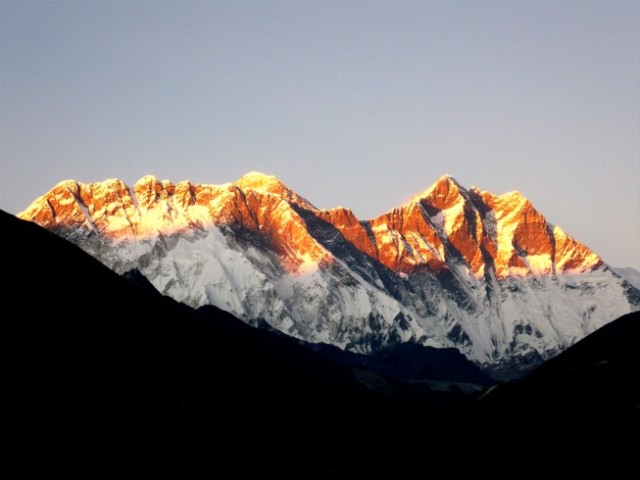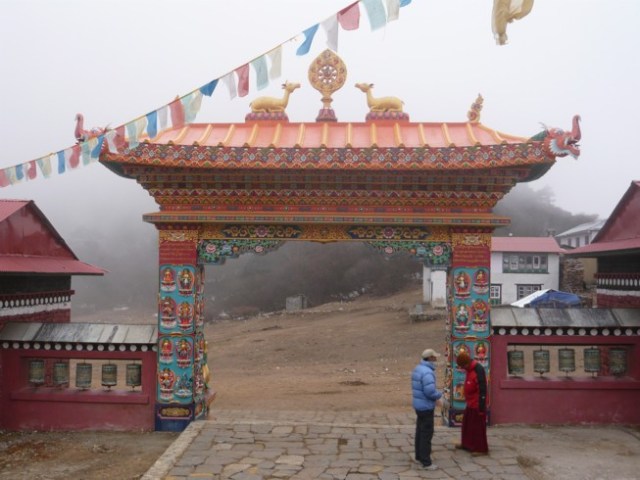…but not literally, unfortunately. I did say I would re-post another travel post from some while back, so here it is.
Four years ago I wrote four short posts about Tengboche. Here I’ve combined them into a single post and added some extra pictures and text to give a little more information about this lovely place.
Tengboche is a monastery complex and a couple of trekking lodges at 3860m on the route up to Everest Base Camp from Lukla, in Nepal. It sits high above the waters of the Dudh Khosi, the rapidly flowing river than runs alongside much of the Everest Trail.
The monastery complex. On arrival in the afternoon, the clouds are low. This seems to be the pattern most days – clear mornings and then the clouds coming in early afternoon. In a general sense, weather patterns in the Himalaya – certainly in some parts, and probably at certain times of the year – can be quite predictable. When I trekked the Annapurna Circuit, for example, we were told one evening that around ten o’clock the next morning there would be strong winds blowing in the valley we were to follow, because that was what happened every day. And blow they did. At ten o’clock.
From inside the monastery grounds. The monastery is a Tibetan Buddhist complex, liberally decorated with the pictures, statues, and symbols to be found in every such place.

Inside Tengboche monastery following a puja (ceremony).
Rightly or wrongly, I don’t like taking photographs of pujas in monasteries. It feels intrusive and bad mannered. I would feel the same in a church, mosque or temple. This has nothing to do with any beliefs of my own, but is born of simple respect.
I noted in my diary: We have just sat in on a chanting puja, but my meditation failed dismally. I was completely unable to concentrate on my breath as all that I could think of were my freezing feet!
It was blooming cold!

This view must have been photographed so many times, but how fantastic is it? Sunset on Everest (left) and Nuptse (right), photographed from Tengboche. This was taken on my third visit; the other two times the clouds failed to clear in the evening, so this was an unexpected treat.

And this is the same view in the morning – but with the addition of Ama Dablam on the right of the picture. Ama Dablam is possibly my favourite mountain; the classic ‘mountain-shaped’ mountain, similar to the Matterhorn.
Close-up of window showing the dawn chorus orchestra.
We were awoken in the mornings by the harsh notes of conch shells and the clashing of symbols. This was part of the morning puja, rather than a summons for coffee and porridge. It does make for an excellent alarm call, though.





Can’t believe it’s just over 25 years ago that we were in Lukla. Had I not had problems I’d been to Tenboche with you and High Hopes?
LikeLiked by 1 person
True. We had other adventures, though.
LikeLike
I have never desired to be a mountain climber, just walking the lower paths and looking up at Everest would be amazing.
LikeLiked by 1 person
None of this was climbing. There are trekking trails all the way up to Everest Base Camp at over 5000 meters (and even higher in some parts).
LikeLike
Your mention of the ‘dawn chorus’ caught my attention. In one of Thomas Merton’s books (Conjectures of a Guilty Bystander) he writes of the dawn chorus, and I assumed he was speaking of the literal birds. Given his eventual involvement with Buddhism, I’m now wondering if the ‘dawn chorus’ might have been rooted in the conch shells and so on. Is such a “dawn chorus” part of daily ritual in such a place, like the Muslim call to prayer?
LikeLiked by 1 person
From my limited experience, many Tibetan Buddhist pujas do involve instruments at various points in the proceedings, although I don’t think they are used as a summons. It was probably happening during a puja, although for all I know they might use it to wake the monks at Tengboche.
There, I’m hedging my bets on that one.
LikeLiked by 1 person
It looks amazing!
LikeLiked by 1 person
Wonderful place, Ann.
LikeLike
Exploring this part of the world is something I wanted to do since I was much, much younger. I don’t think it will ever happen now. It’s really nice to see this and to hear about your experiences, Mick. You were lucky to be there!
LikeLiked by 1 person
I was certainly lucky, yes. But never say never!
LikeLiked by 1 person
There can be enough pictures of those incredible mountains! Thanks for sharing your pictures and stories.
LikeLiked by 1 person
There can never be enough ….
LikeLiked by 1 person
I knew that.
LikeLike
I absolutely agree. I suppose that means I’ll have to do another Himalaya post soon.
LikeLike
These are marvelous pictures, Mick. What a wonderful place to visit.
LikeLiked by 1 person
It absolutely lovely, Robbie. Although a bit cold at night…
LikeLiked by 1 person
Haha, yes, I gathered that…
LikeLiked by 1 person
Beautiful photos, Mick. I’m not a climber so I always imagined that Everest would be ‘a mountain shaped mountain’! Just eyeballing the two highest peaks, its seems as if Everest is just a teensy bit higher?
LikeLiked by 2 people
They look similar in height from Tengboche, but Nuptse is actually 2km closer and 1km lower!
LikeLiked by 1 person
What???? Seriously? That’s a huge difference. -mind boggles-
LikeLiked by 1 person
Angles and all that…
LikeLiked by 1 person
True, but still so deceptive.
LikeLiked by 1 person
As a thumb rule in the Himalayas, the weather changes afternoon. This is more so when it comes to the clouds and rains. This is one of the reasons why most guides recommend an early start for the trek. Another reason is because of strong sunlight.
LikeLiked by 1 person
That sounds highly likely to me, Arv.
LikeLiked by 1 person
🙂
LikeLike
A sacred place and you were blessed to be there. The majestic Himalayas are beyond words.
LikeLiked by 1 person
It is a wonderful place. Lovely atmosphere.
LikeLiked by 1 person
Yes.
LikeLiked by 1 person